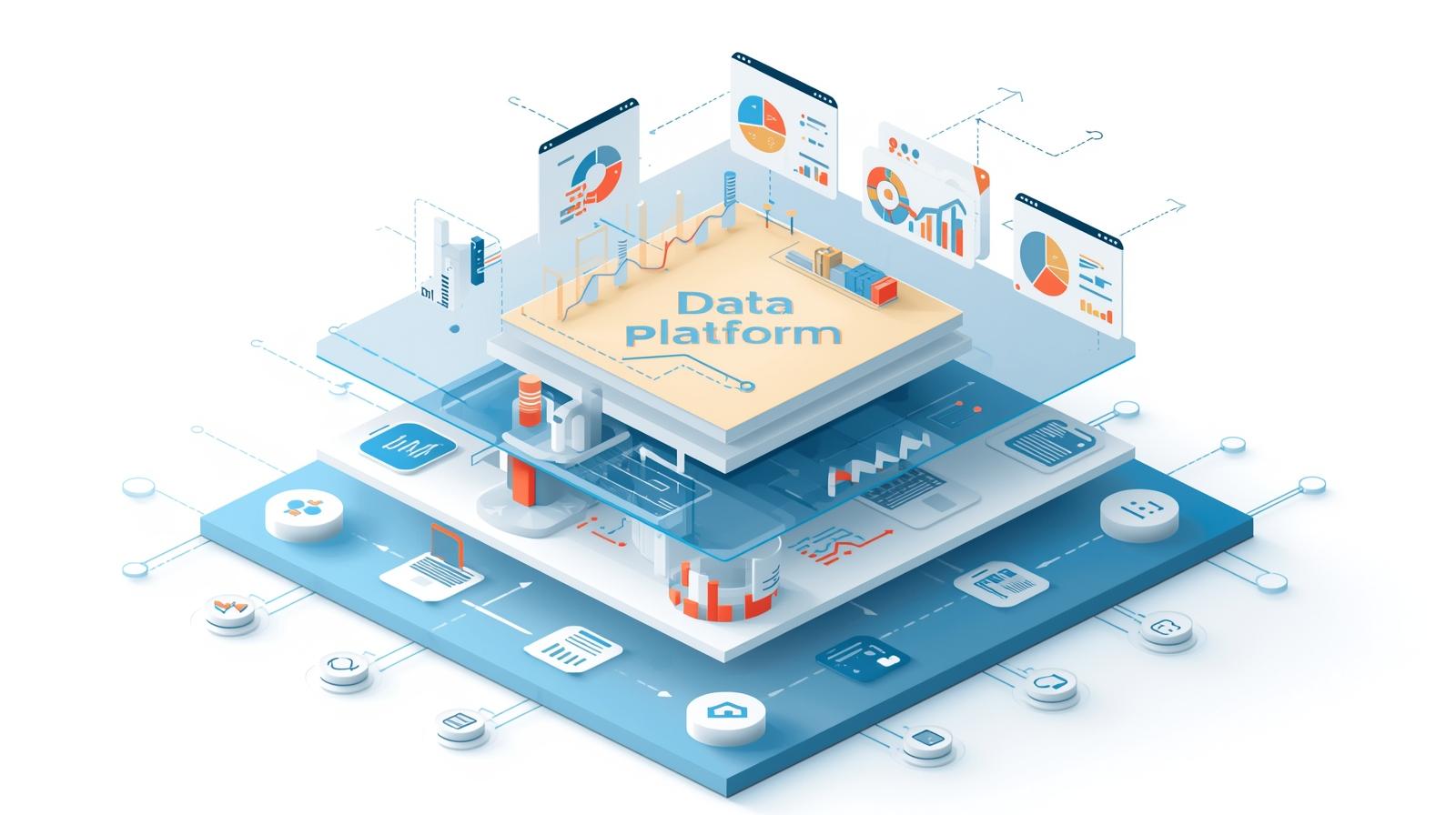Play to listen to the blog post summary ☝️
Every company generates an immense amount of information on a daily basis — sales, inventory, marketing, customer relationships, financial performance. But in practice, much of this data remains hidden in scattered spreadsheets, isolated systems, or manual reports that don’t talk to each other. And the result? Slow decision-making, incomplete insights, and missed opportunities.
This is exactly where a data platform makes the difference. More than just a repository, it’s a structure that integrates, organizes, and transforms raw data into strategic intelligence. It’s like turning on a light in areas of the business that were previously in the dark: bottlenecks you hadn’t noticed, behavior patterns that weren’t visible, and insights that can redefine the direction of your company.
In this article, we’ll explore what a data platform is, how it works, the benefits it can bring, and how it reveals what you still don’t see in your business.
What Is a Data Platform and How Does It Work
A data platform is a technological environment designed to centralize, organize, and make all of a company’s information available in a single place. Instead of keeping data scattered across different systems — such as ERP, CRM, Excel spreadsheets, and department-specific software — the platform acts as a hub that connects all these sources and ensures a unified view of the business.
In practice, it operates as an infrastructure composed of three main layers:
- Integration: connects different systems, databases, and applications, ensuring that all information arrives in a structured and standardized way.
- Storage: consolidates data in modern repositories, such as data lakes and data warehouses, prepared to handle large volumes of information.
- Analysis and visualization: transforms raw data into dashboards, reports, and performance indicators that allow teams to track results in real time.
This combination enables managers and teams to access reliable insights, eliminating the dependence on manual reports and avoiding common errors caused by decentralized information.
In other words, the data platform functions as the backbone of digital transformation, creating the foundation needed to evolve from operational reports to predictive analytics and even artificial intelligence applications.
Why Your Company Needs a Data Platform Today?
Many companies have already realized that making data-driven decisions is no longer a differentiator — it’s a matter of survival. The market moves at a fast pace, and those still relying on manual reports or decentralized information are quickly left behind.
Without a data platform, the main challenges companies face are:
- Information silos: each department works with its own data, with no integration across the organization.
- Slow decisions: delays in consolidating information hold back strategies and critical actions.
- Lack of accuracy: manual reports are prone to errors and inconsistencies.
- Loss of competitiveness: while competitors leverage analytics and artificial intelligence to forecast trends, companies without a solid data foundation make decisions based on guesswork.
On the other hand, by adopting a data platform, your company gains:
- A unified view of the entire operation, from finance to customer experience.
- Faster decision-making, with information delivered at the speed you need.
- Cost reduction, by eliminating manual tasks, rework, and optimizing processes.
- Scalability, building the foundation to support growth and new technologies such as AI and machine learning.
In short, a data platform allows you to stop reacting only to what has already happened and start acting proactively, anticipating trends and identifying opportunities that were previously invisible.
Essential Features of a Modern Data Platform
A modern data platform goes far beyond simply storing information. It must provide capabilities that connect, organize, and transform data into practical business intelligence. Among the key features are:
Integration of multiple data sources
Ability to connect different systems (ERP, CRM, e-commerce, spreadsheets, financial applications, marketing tools, etc.) into a single environment. This eliminates silos and ensures consistency in information.
Secure storage and data governance
Use of data lakes and data warehouses that support large volumes of data, with clear policies for security, access, and compliance (LGPD, ISO, etc.).
Interactive dashboards and automated reports
Availability of visual panels that display indicators and reports automatically generated, avoiding manual rework and reducing errors.
Scalability and performance
Ability to grow alongside the business, handling large volumes of data without compromising processing speed.
Support for advanced analytics and artificial intelligence
Enables not only a view of the past but also the ability to analyze future scenarios through predictive models, machine learning, and generative AI.
Collaboration across teams
An environment that facilitates controlled access for different departments (finance, marketing, operations, sales), ensuring that everyone speaks the same “data language.”
With these features, the data platform becomes a truly strategic tool, ready to transform the way your company collects, organizes, and uses information.
How a Data Platform Reveals Hidden Opportunities in Your Business
One of the greatest advantages of adopting a data platform is the ability to see what was previously invisible. When data is integrated, clean, and organized, patterns begin to emerge and new possibilities become clear. Here’s how this happens in practice:
Identification of patterns and strategic insights
The platform cross-references information from different areas — sales, marketing, operations, finance — and makes it possible to identify behaviors that would be impossible to spot manually. For example: which products sell best in certain regions, which campaigns truly generate loyal customers, or which stages of the sales funnel present the highest drop-off.
Detection of operational bottlenecks
With automated reports and real-time indicators, it becomes possible to identify where the business is losing efficiency. Whether in logistics processes, response times, or wasted resources, the platform highlights the areas that need improvement.
Improvement of customer experience
By unifying information from different contact channels, the company gains a deeper understanding of consumer behavior. This makes it possible to personalize offers, reduce churn, and create more satisfying customer journeys.
Anticipation of market trends
With the support of predictive models, the data platform helps forecast future movements, such as demand seasonality, stock fluctuations, or shifts in buying behavior. This gives the company a significant competitive advantage.
In short, a data platform reveals what intuition alone could never uncover: hidden opportunities, imminent risks, and smarter paths for growth.
Paths to Implement a Data Platform in Your Company
Adopting a data platform is a strategic process that requires planning and long-term vision. It’s not just about choosing technology, but about building a solid foundation so that data truly becomes a business asset.
Key steps for implementation:
Diagnosis
The first step is to understand the company’s current situation: where the data is, how it is used, what bottlenecks exist, and which decisions are most costly when not well supported.
Technology selection
The platform must be compatible with the size of the operation and strategic goals. This involves decisions such as choosing cloud providers (Azure, AWS, Google Cloud), data warehouse models, data lakes, or hybrid architectures.
Integration
Bringing together different sources of information is the heart of the project. At this stage, ERP, CRM, marketing, sales, operations systems, and even spreadsheets must be connected to ensure consistency and reliability.
Governance
Create policies for data security, quality and access. This includes compliance with regulations (such as LGPD) , defining roles and responsibilities, and adopting best practices to ensure data is used properly and ethically.
Data visualization and interaction
With data modeled in an integrated and intelligent way, strategic visualization is what allows the “treasure” of this structure to emerge: insights. This is where the connection between data and BI tools or visualization-oriented languages (such as Power BI or Python) comes in, generating intuitive analyses focused on the company’s key performance drivers.
Continuous evolution
A data platform is not static. After the initial implementation, it’s essential to improve processes, add new data sources, explore advanced analytics, and prepare the ground for artificial intelligence solutions.
Tips to Start Small and Scale
- Begin with a pilot project, focusing on a critical area (e.g., sales or finance).
- Show quick wins, such as reduced rework or faster reporting, to generate internal engagement.
- Scale gradually, adding new areas and functionalities as the company matures in data usage.
- Apply data analysis consistently in monthly, biweekly, and weekly meetings to start building a culture of data-driven decision-making within the team.
The Importance of a Data-Driven Culture
More than technology, the success of a data platform depends on people and processes. It’s essential to foster a data-driven culture, in which managers and teams trust the data and use it as the foundation for daily decisions.
This means investing in training, internal communication, and, most importantly, demonstrating the value of the insights generated. When the entire organization views data as a strategic asset, the platform stops being just a tool and becomes a true engine for growth.
The Role of Specialized Consulting in the Data Journey
Implementing a data platform is not just a technical matter: it involves strategy, cultural change, and the integration of different areas of the business. That’s why many companies struggle to carry out this process on their own. This is where specialized consulting becomes a true differentiator.
How consulting accelerates results:
- Proven experience: professionals who have implemented platforms across different industries know the main challenges and shortcuts.
- Accurate technology selection: helps evaluate the most suitable solutions (Azure, AWS, Google Cloud, Databricks, among others), considering cost, scalability, and business needs.
- Tailor-made architecture: every company has its particularities; consulting designs the ideal structure for both the current scenario and future growth.
- Reduction of errors and rework: prevents common failures in data projects, such as poorly planned integrations or lack of governance.
Faster and More Sustainable ROI
With the right guidance, a company can demonstrate value within the first few months of the project, ensuring internal adoption and return on investment. In addition, consulting follows the evolution of the platform, suggesting continuous improvements so the business doesn’t fall behind in the face of market innovations.
Consulting works not only on the technical side but also in training teams and creating processes that encourage the strategic use of data.
The data your company generates every day already carries answers to questions you may not have even asked yet. But without integration, governance, and analysis, those answers remain invisible — hidden in spreadsheets, isolated systems, or fragmented reports.
A data platform is what transforms this scenario: it connects information, reveals hidden opportunities, anticipates risks, and creates a solid foundation for innovation.
If your company is still in the early stages, or if it already has BI initiatives but lacks integration, governance, or speed, now is the time to act. Don’t let opportunities remain hidden in the data you already have.
👉 Talk to Equal and see how a data platform can reveal what you still don’t see in your business.



